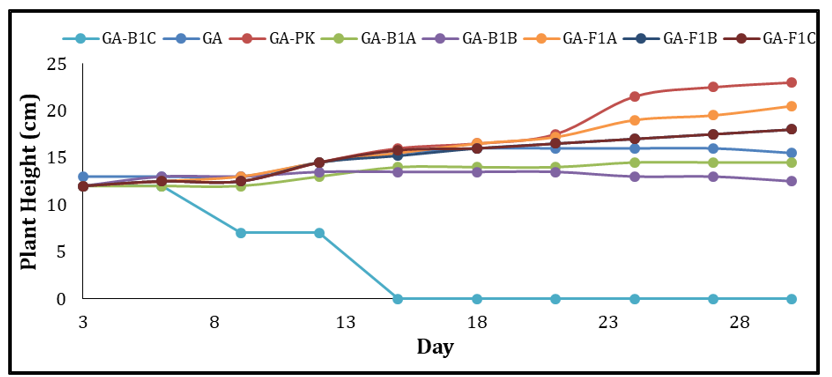Utilization of Coal Ash as an Ameliorant to Enhance Growth and Nutrient Availability for Chili Plants (Capsicum annuum L.) on Peat Soil
DOI:
https://doi.org/10.26555/ijce.v2i2.1412Keywords:
Amelioran, Bottom ash, Coal ash, Chili plants, Peat soilAbstract
Peat soil has limitations in nutrient content and low pH, thus requiring improvement efforts to support optimal plant growth.This study aims to examine the effect of adding coal ash (fly ash and bottom ash) on the growth of chili plants in peat soil media.The research design uses a combination of peat soil, manure, and coal ash from the power plant, which are tested under several treatments.The main parameters observed were plant height and nutrient analysis in the growing medium.The results show that the combination of peat soil, manure, and bottom ash from PLTU 2 (GA-B2B) produced the highest plant growth (26.3 cm).The addition of coal ash increases the CaO content in the growing medium, which plays a role in improving the chemical properties of the soil.However, nitrogen levels tend to decrease with the increase in coal ash dosage.Thus, coal ash has the potential to act as an ameliorant to improve the productivity of peat soil, especially when combined with organic fertilizers.
References
[1] A. V. Febriani, F. F. Hanum, M. Setiawan, and J. Kuncara, “Optimalisasi Mutu Batubara Indonesia : Kajian Metode dan Potensi dalam Peningkatan Nilai Kalori Batubara,” Eksergi, vol. 21, no. 2, pp. 70–76, 2024, doi: https://doi.org/10.31315/e.v21i2.11761.
[2] A. Ammarullah, “Analisis Estimasi Kebutuhan Listrik Untuk Memenuhi Kebutuhan Smart Grid di Jawa Barat Sampai Tahun 2032,” Sains dan Teknol., vol. 11, no. 3, pp. 2024–1235, 2024, doi: doi.org/10.47668/edusaintek.v11i3.1250.
[3] B. S. Wardhana, F. F. Hanum, Z. Mufrodi, and S. Jamilatun, “Review : Effect Of Material Characteristics , And Process Conditions In Reducing Gaseous Pollutants Using Fly Ash ( Fa ) - Based Adsorbent,” J. Sains Nat., vol. 14, no. 4, pp. 169–178, 2024, doi: 10.31938/jsn.v14i4.
[4] F. F. Hanum, S. Salamah, A. R. Sanuhung, and B. S. Wardhana, “Study On The Potential Contamination Of Heavy Metals : Analysis Of Cr And Pb Contents From Power Plants,” J. Sains Nat., vol. 14, no. 1, pp. 53–61, 2024, doi: https://doi.org/10.31938/jsn.v14i1.689.
[5] P. Cong and Y. Cheng, “Advances in geopolymer materials : A comprehensive review,” J. Traffic Transp. Eng. (English Ed., vol. 8, no. 3, pp. 283–314, 2021, doi: https://doi.org/10.1016/j.jtte.2021.03.004.
[6] Imran, F. F. Hanum, B. Setya Wardhana, E. S. Totok;, and A. V. Febriani, “Karakterisasi Komposisi Kimia Dan Potensi Pemanfaatan Campuran Tanah Gambut Kalimantan Timur Dengan Fly Ash Dan Bottom Ash Untuk Pertanian,” J. Cryst. Publ. Penelit. Kim. dan Ter., vol. 6, no. 2, pp. 115–123, 2024, doi: https://doi.org/10.36526/jc.v6i2.4250.
[7] S. Bahri, F. S. Harahap, B. A. Dalimunthe, I. P. A. Septyani, and E. Indrawanis, “Physical Characteristics of Peat Soil in Oil Palm Plantation, Simpang Kanan Village, Simpang Kanan Subdistrict, Rokan Hilir,” J. Agron. Tanam. Trop., vol. 4, no. 2, pp. 289–294, 2022, doi: 10.36378/juatika.v4i2.1938.
[8] N. A. Permatasari, D. Suswati, F. B. Arief, A. A. Aspan, and A. Akhmad, “Identifikasi Beberapa Sifat Kimia Tanah Gambut Pada Kebun Kelapa Sawit Rakyat Di Desa Rasau Jaya Ii Kabupaten Kubu Raya,” Agritech J. Fak. Pertan. Univ. Muhammadiyah Purwokerto, vol. 23, no. 2, p. 199, 2021, doi: 10.30595/agritech.v23i2.12616.
[9] N. Gofar, Bakri Bakri, Aditya Surya Wardhana, and Tri Putri Nur, “Aplikasi Biostimulan dalam Budidaya Tanaman Cabai Merah (Capsicum annuum L.) pada Ultisols,” Pros. Semin. Nas. Pembang. dan Pendidik. Vokasi Pertan., vol. 3, no. 1, pp. 603–622, 2022, doi: 10.47687/snppvp.v3i1.357.
[10] N. E. Elawati, C. S. Fahik, A. N. Izza, and F. A. Rahmawati, “Pengaruh Abu Dasar Batubara dan Media Tanah Kompos terhadap Pertumbuhan Tanaman Cabe Merah (Capsicum annuum),” Bioeduscience, vol. 7, no. 1, pp. 1–7, 2023, doi: 10.22236/jbes/7111185.
[11] A. Farooq et al., “Effect of calcium oxide , zinc oxide nanoparticles and their combined treatments on growth and yield attributes of Solanum lycopersicum L .,” J. King Saud Univ. - Sci., vol. 35, no. 5, p. 102647, 2023, doi: 10.1016/j.jksus.2023.102647.
[12] J. Sun et al., “Growth , Photosynthetic Characteristics , and Carbon and Nitrogen Metabolism in Tomato,” Plant, vol. 12, p. 4175, 2023, doi: https://doi.org/10.3390/plants12244175.
[13] S. J. Leghari, N. A. Wahocho, G. M. Laghari, and A. H. Laghari, “Role of Nitrogen for Plant Growth and Development : A review,” Adv. inEnvironmental Biol., vol. 10, no. 9, pp. 209–218, 2016.
[14] Simatupang, D., Astiani, D., & Widyastuti, T. (2018). Pengaruh Tinggi Muka Air Tanah Terhadap Beberapa Sifat Fisik Dan Kimia Tanah Gambut Di Desa Kuala Dua Kabupaten Kubu Raya. Jurnal Hutan Lestari, 6(4).
[15] G. Rifaldy, Wijaya, and I. Saleh, “Pengaruh Konsentrasi Pupuk Organik Cair Dan Takaran Pupuk Nitrogen Terhadap Pertumbuhan Dan Hasil Tanaman Cabai Rawit (Capsicum Frutescens L.) Kultivar Dewata F1,” J. Agroswagati, vol. 7, no. 2, p. 87, 2019, doi: 10.33603/agroswagati.v7i2.2798.
[16] A. Fahmi, S. Nuryani, H. Utami, and B. Radjagukguk, “Pengaruh Interaksi Hara Nitrogen Dan Fosfor Terhadap Pertumbuhan Tanaman Jagung (Zea Mays L) Pada Tanah Regosol Dan Latosol.,” Ber. Biol., vol. 10, no. 3, pp. 297–304, 2010.
[17] I. R. Mir, H. Gautam, N. A. Anjum, A. Masood, and N. A. Khan, “Calcium and nitric oxide signaling in plant cadmium stress tolerance: A cross talk,” South African J. Bot., vol. 150, pp. 387–403, 2022, doi: https://doi.org/10.1016/j.sajb.2022.07.039.

Downloads
Published
Issue
Section
License
Copyright (c) 2024 Farrah Fadhillah Hanum, Budi Setya Wardhana, Imran, Annisa Vada Febriani

This work is licensed under a Creative Commons Attribution-ShareAlike 4.0 International License.



